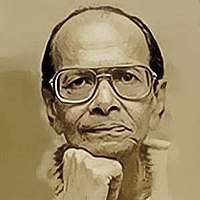Subinoy Roy
| Subinoy Roy | |
|---|---|
 শ্রী সুবিনয় রায় | |
| Background information | |
| Born |
November 8, 1921 Kolkata, West Bengal, India |
| Died | January 9, 2004 (aged 82) |
| Genres | Rabindra Sangeet Singer |
| Occupation(s) | Singer |
Subinoy Roy (Bengali: সুবিনয় রায় Subinoy Roy) (8 November 1921 - 9 January 2004) was an Indian singer, considered one of the best-known exponents of the songs of Rabindranath Tagore: (Rabindrasangeet).[1]
Early life
Roy was initiated to Rabindra Sangeet by his mother at a very early age. Later, while studying Chemistry in graduation level at Shantiniketan, he came in contact with Maestro Shailajaranjan Majumder and started learning Rabindra Sangeet from him. He learned Indian Classical Music from Ramesh Chandra Bandyopadhyay and Girija Shankar Chakrabarty.
Profession
At some time, he left Shantiniketan and pursued studying library science from England and joined Indian Statistical Institute as librarian. Still, he became renowned as a teacher of Rabindra Sangeet that too for being an authority in Rabindra Sangeet in its purest form. He became a regular artist of Rabindra Sangeet in the All India Radio since 1943[2]. His first gramaphone record was released on 1949, with two songs; "তুমি ডাক দিয়েছ কোন সকালে" and "এই করেছো ভালো"[3]
Though Subinoy was a puritan in rendition of Rabindra Sangeet, he was adaptable and open to liberalization. Once interviewed on expiry of copyright of the songs written by Rabindranath Tagore, Subinoy Roy expressed:
"I'm not sure where all these do's and don'ts came from.... Rabindranath liked the esraj, violin, flute and tabla with his songs, but if the guitar, synthesizer and drums existed at the time, I'm sure he would have tried those out too. At least he wouldn't reject them if they made his songs sound better.".[4]
Contribution in Music
Subinoy Roy in his book রবীন্দ্র সংগীত সাধনা (Rabindra Sangeet Sadhana) delved into the intrinsic elements of music which a learner should grasp. He preached on use of তানপুরা (Tanpura) for the learners. He wrote:
"তানপুরার সাহায্যে সংগীতচর্চা করলে দুটি সাক্ষাৎ সুফল পাওয়া যায়; প্রথমত এতে কণ্ঠস্বরের তীক্ষ্ণতা (keenness) ও অনুনাদ (resonance) বৃদ্ধি পায়, দ্বিতীয়ত বিভিন্ন স্বরগুলিকে সুদৃঢ় ও নিখুঁতভাবে কণ্ঠে প্রকাশ করবার ক্ষমতা লাভ করা যায়"[5].
Death
Roy had lost his wife just four days before his death. He breathed his last in a city hospital in Kolkata. His mortal remain was brought to his Salt Lake residence and then to Rabindra Sadan, where many offered their final tribute[6].
Legacy
Subinoy Roy was a renowned teacher and a revered exponent of Rabindra Sangeet in its purest form, both in terms of notational and emotional pristinity[7]. He was survived by his son Suranjan, who himself along with fans, followers, disciples and students of a music school founded by Subimal himself, are sincerely engaged in carrying forward the ideologies, concepts and style of singing of maestro Subinoy Roy.
Bibliography
Roy, Subinoy (1379 BS - 1972). রবীন্দ্র সংগীত সাধনা (Rabindra Sangeet Sadhana), A Mukherjee and Sons:Kolkata.
References
- ↑ Krishna Dutta, Anita Desai (2003). Calcutta: A Cultural and Literary History. Signal Books. p. 226. ISBN 1-902669-59-2.
- ↑ "The City Diary". The Telegraph. January 10, 2004. Retrieved 2018-08-16.
- ↑ "সুবিনয় রায়কে শ্রদ্ধাঞ্জলি". Ei Samay. 31 October 2015. Retrieved 2018-08-16.
- ↑ "Rabindranath Tagore's music may finally unshackle with Visvabharati's copyright set to end". India Today. October 23, 2000. Retrieved 2018-08-16.
- ↑ Roy, Subinoy (1972). রবীন্দ্র সংগীত সাধনা (Rabindra Sangeet Sadhana). Kolkata: A Mukherjee and Sons.
- ↑ "কলকাতার কড়চা". Ananda Bazar Patrika. 6 November 2017.
- ↑ "Unsung people who sang his songs". Retrieved 2018-08-16.